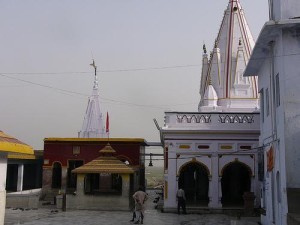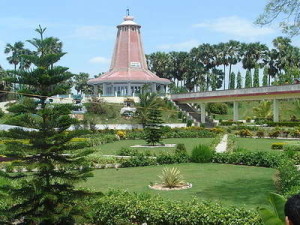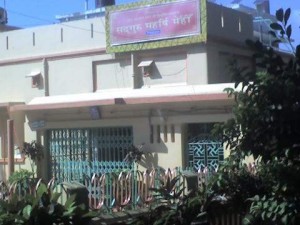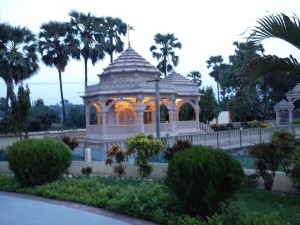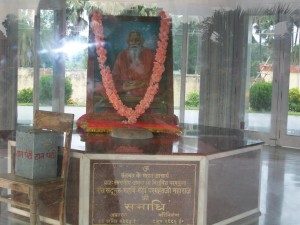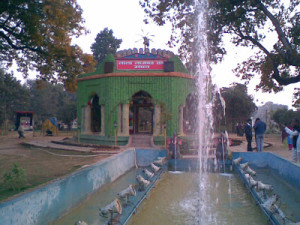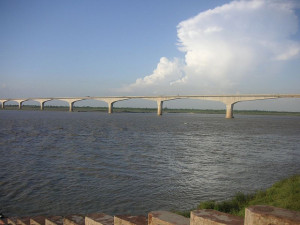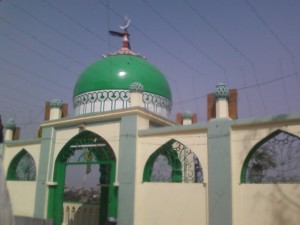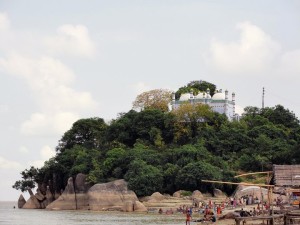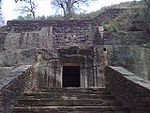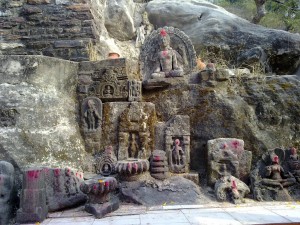BHAGALPUR DISTRICT
Bhagalpur is a town and the administrative headquarters of Bhagalpur district Bihar state in the eastern part of India. Reference to Bhagalpur can be found in Indian epics like the Ramayana and the Mahabharata where Bhagalpur has been described as the kingdom of 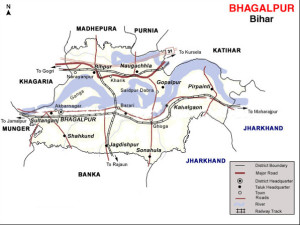 Anga. The main language of Bhagalpur is Angika. The gangetic plain of Bhagalpur is very fertile.Bhagalpur is known as SILK CITY as it is famous world wide for its silk production. The silk industry in this city is 200 of years old and a whole clan exist that has been producing silk for generations. Bhagalpur is well known for its sericulture, manufacture of silk yarn and weaving them into lovely products. This silk is of a distinct and special type. It is known as Tussah or Tusser Silk. Bhagalpur silk is a household name in India and the lovers of Bhagalpur silk fabrics is found allover the India.
Anga. The main language of Bhagalpur is Angika. The gangetic plain of Bhagalpur is very fertile.Bhagalpur is known as SILK CITY as it is famous world wide for its silk production. The silk industry in this city is 200 of years old and a whole clan exist that has been producing silk for generations. Bhagalpur is well known for its sericulture, manufacture of silk yarn and weaving them into lovely products. This silk is of a distinct and special type. It is known as Tussah or Tusser Silk. Bhagalpur silk is a household name in India and the lovers of Bhagalpur silk fabrics is found allover the India.
How To Reach
By Airport :-
Bhagalpur city had an airport which was functional during 1970-1980 with regular flights to nearby major cities.
By Rail :-
Bhagalpur lies on the broad gauge Loop line of the East Central railway under Bhagalpur Division, running from Kiul to Burdwan. Important stations in this District include Sultanganj, Bhagalpur, Sabour, Kahalgaon.
A branch line runs from Bhagalpur to Mandar Hill (21 Kms.). North Bhagalpur is served by the Barauni-Katihar section of the North Eastern Frontier Railway. Narayanpur, Bihpur, Naugachia and Katihar Railway Stations lie on this line.
The new rail lines which are under construction are Sultanganj to Deoghar, Bhagalpur to Dumka, Bhagalpur Godda via Hansa Diya, Banka to Deoghar
The major facilities available are Waiting rooms, retiring room, computerised reservation facility, Reservation Counter, Vehicle parking etc.The vehicles are allowed to enter the station premises. There are refreshment rooms vegetarian and non-vegetarian, tea stall, book stall, post and telegraphic office and Government Railway police(G.R.P) office. Automatic ticket vending machines have been installed to reduce the queue for train tickets on the station.
Bhagalpur Junction is among the selected Railway Stations of India where Automated Escalators are being installed. There would be Escalators for all the 6 Platforms.
By Road :-
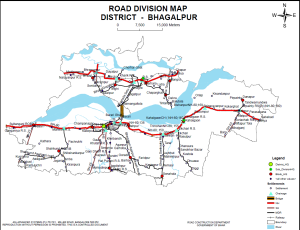 Well connected to other city through National Highway-31,80 SH-19,22,23,25,58 Other road-Bihpur Gopalpur Road,Ghogha Sanhaula Road,Bhagalpur Amarpur Kotwali Road,Shahkund Asarganj road,Vikramshila Setu Road,Kataria Tintanga Road National Highway 31 runs through the entire Naugachia Police District and subdivision. This highway connects the subdivisions directly to Patna via Begusarai and Khagaria and runs up to Guwahati via Purnea-Kishanganj. In addition, Mokama Farakka road has also been declared as National Highway No. 81. It passes through Bhagalpur town and Kahalgaon.
Well connected to other city through National Highway-31,80 SH-19,22,23,25,58 Other road-Bihpur Gopalpur Road,Ghogha Sanhaula Road,Bhagalpur Amarpur Kotwali Road,Shahkund Asarganj road,Vikramshila Setu Road,Kataria Tintanga Road National Highway 31 runs through the entire Naugachia Police District and subdivision. This highway connects the subdivisions directly to Patna via Begusarai and Khagaria and runs up to Guwahati via Purnea-Kishanganj. In addition, Mokama Farakka road has also been declared as National Highway No. 81. It passes through Bhagalpur town and Kahalgaon.
Inscription
Inscription of Sikandar Shah of Bengal :-
An epigraph, on a loose slab, recovered from champanagar now in possession of Shri P.C.Singh than Senior Deputy Collector, Bhagalpur, belongs to the reign of Sikander Shah, son of Ilyas Shah of Bengal.Dated A.H 769 (A.D1367), it states that a mosque was built by the great khan Taghi khan, son of Bughra Khan. (ASI 1962-63)
Inscription of the Mughal :-
A metrical record in Persian; in Nastaliq characters, belonging to the reign of Mughal Emperor, Shah Jahan states that a mosque was constructed in Khurramabad by Farasat Khan in A.H 1051 (A.D 1641-42). The place-name Khurramabad seems to be on account of the association of prince Khurram (i.e Shah Jahan). Another inscription from the same place of the time of Aurangzeb records the construction of a mosque by Nur Afshan() in AH 1073(A.D1662-63) ASI (1988-89)
Miscellaneous inscription :-
the epigraph refers for the construction of a mosque by Roshan’ AH in A.H1280 (AD 1863-64) ASI (1988-89)
Inscription ( Museum, Patna) :-
An inscription, in sanskrit and in late Brahmi of the fourth – fifth century A.D., engraved on a sandstone coping- stone of a railing discovered at Colgong, records that an unnamed Buddhist monk who belonged to the royal family of Lanka (Ceylon) performed religious worship at the Ratnatraya.Inscription is now in Patna museum. (ASI 1963-64).
Popular tourist destinations
Vikramshila Gangetic Dolphin :-
 Vikramshila Gangetic Dolphin Sanctuary is located in Bhagalpur.Dolphins were once popular in the Ganges, though they are rare today.The Ganga dolphin is one of the four freshwater dolphin species in the world. The other three are found in the Yangtze river in China, the Indus river in Pakistan and the Amazon river in South America. The 50 km stretch of the Ganges from Sultanganj to Kahalgaon has been declared the Vikramshila Gangetic Dolphin Sanctuary.Designated in 1991, it is the only protected area for the endangered Gangetic dolphins in Asia. Zoologists from Patna University claim to have sighted about 40 dolphins in the sanctuary.Kahalgaon is made up of three small islands.It is the place to watch the dolphins at play around these islands.The Sanctuary also contains rich diversity of other threatened aquatic wildlife, including the Indian smooth-coated otter Lutrogale perspicillata, gharial Gavialis gangeticus, a variety of. The Bihar government took the decision in the wake of the killings of four of the Dolphin to appoint 20 dolphin ‘mitras’ in villages between Sultanganj and Kahalgaon to create awareness to save dolphins in the sanctuary.
Vikramshila Gangetic Dolphin Sanctuary is located in Bhagalpur.Dolphins were once popular in the Ganges, though they are rare today.The Ganga dolphin is one of the four freshwater dolphin species in the world. The other three are found in the Yangtze river in China, the Indus river in Pakistan and the Amazon river in South America. The 50 km stretch of the Ganges from Sultanganj to Kahalgaon has been declared the Vikramshila Gangetic Dolphin Sanctuary.Designated in 1991, it is the only protected area for the endangered Gangetic dolphins in Asia. Zoologists from Patna University claim to have sighted about 40 dolphins in the sanctuary.Kahalgaon is made up of three small islands.It is the place to watch the dolphins at play around these islands.The Sanctuary also contains rich diversity of other threatened aquatic wildlife, including the Indian smooth-coated otter Lutrogale perspicillata, gharial Gavialis gangeticus, a variety of. The Bihar government took the decision in the wake of the killings of four of the Dolphin to appoint 20 dolphin ‘mitras’ in villages between Sultanganj and Kahalgaon to create awareness to save dolphins in the sanctuary.
Udhuwa Lack Bird Sanctuary(Barharwa) :-
Situated not very far away from the Ganges, it comprises twin lakes of Pataura (155 ha) and Berhale (410 ha), total area being 565 ha, with surrounding semi permanent wetlands. Both lakes remain connected during monsoon and winter whereas the former surrounded by small hillocks and crop land is linked through Udhuwa Nala to the Ganges the backwater of which sustains the lake. 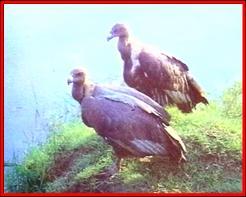 Birds seen at water surface here are Gull, Jacana, Teal, Cormorant, Dabchick, Darter etc. and those on muddy banks are Wader, Lapwing, Plover, Wagtail, Egret, Heron, Ibis, Stork and Pratincole. Birds of open ground and grassland here include Blue Rock Pigeon, Lark, Bee-eater, Sparrow, Myna, Pipit, Bulbul etc.
Birds seen at water surface here are Gull, Jacana, Teal, Cormorant, Dabchick, Darter etc. and those on muddy banks are Wader, Lapwing, Plover, Wagtail, Egret, Heron, Ibis, Stork and Pratincole. Birds of open ground and grassland here include Blue Rock Pigeon, Lark, Bee-eater, Sparrow, Myna, Pipit, Bulbul etc. 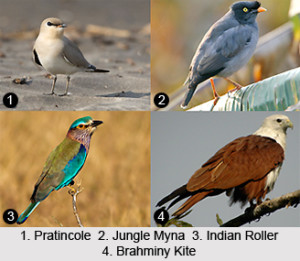 Mynas are represented here by six species, Pied Myna, Indian Myna, Bank Myna, Jungle Myna, Brahminy and Grey-headed Myna. Among birds of prey are Tern, Brahminy Kite, Fishing Eagle, Hawk and Vulture. House and Palm Swift, Swallow, Kingfisher, Drongo, Indian Roller and Parakeet are also common here.
Mynas are represented here by six species, Pied Myna, Indian Myna, Bank Myna, Jungle Myna, Brahminy and Grey-headed Myna. Among birds of prey are Tern, Brahminy Kite, Fishing Eagle, Hawk and Vulture. House and Palm Swift, Swallow, Kingfisher, Drongo, Indian Roller and Parakeet are also common here.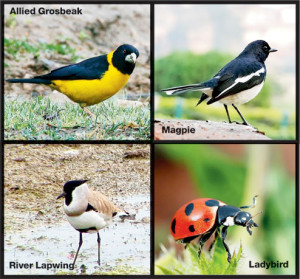 Migratory birds visiting the lake during winter include Black-headed & Brown-headed Gull, Grey-headed Lapwing, Little-ringed Plover, Red & Green Shanks, Spotted Green Shanks, Common Sandpiper, Temminck’s Stint, Yellow & White Wagtail, Blue-throat, Western Swallow etc.
Migratory birds visiting the lake during winter include Black-headed & Brown-headed Gull, Grey-headed Lapwing, Little-ringed Plover, Red & Green Shanks, Spotted Green Shanks, Common Sandpiper, Temminck’s Stint, Yellow & White Wagtail, Blue-throat, Western Swallow etc.
Gurudwara Bari Sangat Sri Guru Tegh Bahadur Ji Chowki:-
Bhagalpur had two Sikh Sangats when Guru Tegh Bahadur visited it in 1667. Guru Tegh Bahadur is said to have stayed at Bari Sangat on Burhanath Ghat of which what is left is a stone slab, still considered holy. Over it Sardar Inder Singh Atwal got a room built in 1974. On every amavas, Guru Granth Sahib is brought from Gurudwara Singh Sabha in the interior of the town and a congregation is held here with the holy book placed on the old slab called Chauki sahib. The place itself is named Gurdwara Bari Sangat Sri Guru Tegh Bahadur Ji Chowki Sahib. An old hand-written copy of Guru of Guru Granth Sahib acquired from the former Udasi priest of the shrine is preserved in Gurdwara Singh Sabha. The other place, Chhoti Sangat, also on the Ghat a little distance away from Bari Sangat has since been converted into a Hindu temple.
Burhanath Mahadev Temple:-
It is situated on the river bank in Jogsar Mohallah.Spread over three acres Being one of the oldest temple in the region it witnesses influx of devotees throughout the year. Reference of Baba Budhanath can be found in Shiva Purana as Baba Bal Vridheshwar Nath. Also, this name has been stated in the first segment of the eighth segments of Shiva Purana . The lingam of this place of worship is self-incarnated nevertheless as to when it come into being is still unknown. Idol of Ma Bhavani can be seen beside the Shivalinga. As per legend the idol of Ma Bhavani is actually that of Ma Chandi of Munger, that travelled from Munger through the Ganga river and banked near the Budhanath temple. One day the goddess came in the dreams of a man there on the premises. He found and placed her on the campus of Budhanath temple.
Maharshi mehi ashram(Kuppaghat) :-
Maharshi mehi ashram is situated on the bank of River Ganges, also famous by the name of Kuppaghat .
It is an ideal place to spend the evening in a charming environment. The ashram hides an old underground passage leading to various destinations. They are open to visitors but only when accompanied by an attendant.
Department Of Gandhian Thought :-
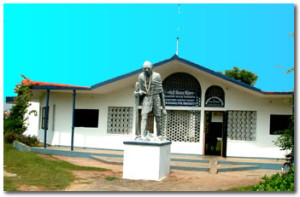 This is situated 2 Km west from Bhagalpur Railway Station. This is the first post graduate department under Tilka Manjhi Bhagalpur University where the course of Gandhi Darshan is conducting .M.A.Diploma Course (Management of Voluntary Organization and Social Development) Ph.D.The initial foundation of the Department was contemplated by Late Padmabhushan Dr. Ramdhari Singh ‘Dinkar’, then Vice Chancellor of this University who started an exercise in this regard. However the Department could be started in 1980, and the Postgraduate teaching was started in 1981.
This is situated 2 Km west from Bhagalpur Railway Station. This is the first post graduate department under Tilka Manjhi Bhagalpur University where the course of Gandhi Darshan is conducting .M.A.Diploma Course (Management of Voluntary Organization and Social Development) Ph.D.The initial foundation of the Department was contemplated by Late Padmabhushan Dr. Ramdhari Singh ‘Dinkar’, then Vice Chancellor of this University who started an exercise in this regard. However the Department could be started in 1980, and the Postgraduate teaching was started in 1981.
Sandish Compound :-
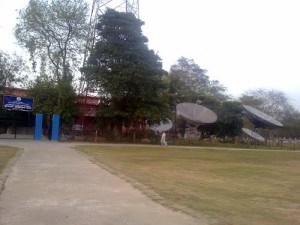 Located at Khanjarpur in Bhagalpur City near to Jaiprakash Narayan Udyan. It has a Doordarshan TV Centre in it. At Sandish Compound the political gathering, Fun Fair, Shopping sales, Music Events, New year events and independence day , republic day function ,Rawan and Kumbh karan effigy burning during Dashhara organized. Sandish Compound also used by Bhagalpur Peoples for Morning Walk, Evening Gathering. Children and Youth come here to play various games as – Cricket, Athletics, Volleyballs etc. This ground also used by various sports associations to organize Cricket and other sports tournament.
Located at Khanjarpur in Bhagalpur City near to Jaiprakash Narayan Udyan. It has a Doordarshan TV Centre in it. At Sandish Compound the political gathering, Fun Fair, Shopping sales, Music Events, New year events and independence day , republic day function ,Rawan and Kumbh karan effigy burning during Dashhara organized. Sandish Compound also used by Bhagalpur Peoples for Morning Walk, Evening Gathering. Children and Youth come here to play various games as – Cricket, Athletics, Volleyballs etc. This ground also used by various sports associations to organize Cricket and other sports tournament.
It is told that it was a big ditch. One collector of Bhagalpur whose name was Mr Sandish. While during his morning walk he started throwing debrises in it as a result other passersby also did the same thing.Then an idea of filling it came under a systematic programme which resulted in outcome of a good useful compound .Now the name has been changed to Gandhi Maidan.
Jai Prakash Narayan Udyan :-
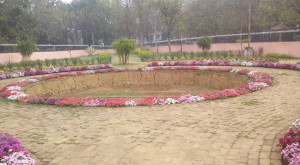
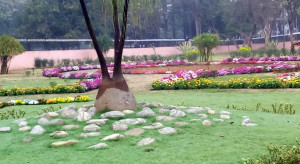 It is situated at Khanjarpur in Bhagalpur City.One of the most visited amusement place, it is 30 Year Old Park of Bhagalpur. It has Zoo and lush green forest; well known for best place for children’s entertainment in Bhagalpur. Peoples come here to enjoy New Year Fest, so it also known picnic spot in Bhagalpur. In Zoo you can view some beautiful birds and some animals.
It is situated at Khanjarpur in Bhagalpur City.One of the most visited amusement place, it is 30 Year Old Park of Bhagalpur. It has Zoo and lush green forest; well known for best place for children’s entertainment in Bhagalpur. Peoples come here to enjoy New Year Fest, so it also known picnic spot in Bhagalpur. In Zoo you can view some beautiful birds and some animals.
Tomb of Ibrahim Hussain Khan (Khanjarpur):- Bhagalpur also has the grand tomb of Ibrahim Hussain Khan in Khanjarpur which is one of the best monuments in North Bihar.
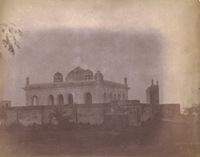 Photograph of the Mausoleum of Ibrahim Husain Khan at Bhagalpur in Bihar, taken by Henry Baily Wade Garrick in the 1880s. The List of Ancient Monuments in Bengal (1896), pp. 422-23, describes the Mausoleum as “a very pretty monument, in good condition” which was “repaired in 1845 by the Magistrate of Bhagalpur.” The tomb is rectangular in plan with a central pointed dome surrounded by four domed kiosks or ‘chhatris’. There are decorative finials on the roof at each of the four corners and a monumental gateway to the south.
Photograph of the Mausoleum of Ibrahim Husain Khan at Bhagalpur in Bihar, taken by Henry Baily Wade Garrick in the 1880s. The List of Ancient Monuments in Bengal (1896), pp. 422-23, describes the Mausoleum as “a very pretty monument, in good condition” which was “repaired in 1845 by the Magistrate of Bhagalpur.” The tomb is rectangular in plan with a central pointed dome surrounded by four domed kiosks or ‘chhatris’. There are decorative finials on the roof at each of the four corners and a monumental gateway to the south.
The Residence of Sharat Chandra Chattopadhyaya :-
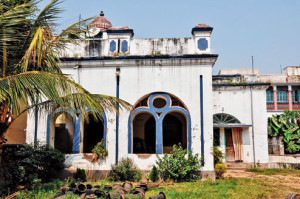 It is situated in Adampur . Sharat Chandra Chattopadhyay was born on September 15, 1876,at Debanandapur in Hooghly West Bengal . He had his early schooling in a Pathshala in his village.
It is situated in Adampur . Sharat Chandra Chattopadhyay was born on September 15, 1876,at Debanandapur in Hooghly West Bengal . He had his early schooling in a Pathshala in his village.
In 1893, he moved to his maternal uncle’s home at Bhagalpur. Although he began as a fine arts student, Chattopadhyay left his studies due to his persistent state of poverty. He received his early education while residing at his paternal uncle’s house in Bhagalpur. Sharat Chandra Chattopadhyaya is known to have roots in the city. He had written his famous novel Devdas in Bhagalpur itself. He spent 20 years of his life in Bhagalpur and major parts of his novels were either written in Bhagalpur or based on his experience in Bhagalpur.
Lala Lajpat Park :-
The Lala Lajpat Park is one of tourism place of Bhagalpur. It is very beautiful place. There are many kind of flowers and trees are in this park. Many of baby toys are also available there for children.
The Dargah (Tomb) of Ghuran Sah Pir Baba :- It is located near SM college. People visit here everyday but on friday it is full packed.
Bhagwandas library :- It is situated in Nayabazar mohala .It has large collection of novels of Hindi and Bengali writers ,besides books of other subjects of interest.
Christ Church :- It is situated near the city tower.
Old symmetry :- It is in a very ruined shape.
Bhagalpur museum :-
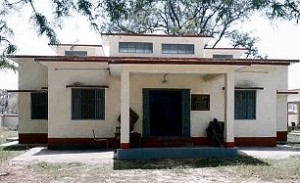 It is situated besides Burh Nath temple. It is established on 11th November 1976 with assortment of artworks and archaeological leftovers. Artifacts belonging to different phases of history can be found in Bhagalpur. A good number of them have been collected for this museum. The galleries of museum also contains sculptures, art work anthology of manuscripts and more.Points of attractions in this museum are
It is situated besides Burh Nath temple. It is established on 11th November 1976 with assortment of artworks and archaeological leftovers. Artifacts belonging to different phases of history can be found in Bhagalpur. A good number of them have been collected for this museum. The galleries of museum also contains sculptures, art work anthology of manuscripts and more.Points of attractions in this museum are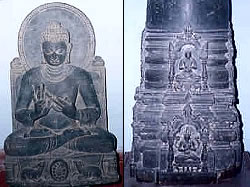 figurine of Buddha collected from Sultanganj & Sarnath, Statues of Ganesha collected from Mandar,Idols of Mahishasurmardini excavated from Bank regine, Idols of Maa Durga excavated from the area where CMS School Bhagalpur is located & Yakshini collected from Shahkund
figurine of Buddha collected from Sultanganj & Sarnath, Statues of Ganesha collected from Mandar,Idols of Mahishasurmardini excavated from Bank regine, Idols of Maa Durga excavated from the area where CMS School Bhagalpur is located & Yakshini collected from Shahkund
The museum is open from 10 am to 5:30 pm during summer and 10 am to 5 pm during winter .It remains closed on Mondays and government holidays.
Vikramshila Setu :-
Vikramshila Setu is a new bridge constructed on river Ganges, in city of Bhagalpur, Bihar, India. This has been constructed to connected city of Barari Ghat,Bhagalpur and Naugachia,Purnia.The bridge is 4.7 km in length. This bridge is the second largest bridge in Bihar after the Mahatma Gandhi Setu, Patna and also in northern India.The Bridge Lies in the Area of Vikramshila Gangetic Dolphin Sanctuary and rare Gangetic dolphins can be spotted in the area.
Sanjay Gandhi Javil Udhyan(Park) :- It is a famous park of Bhagalpur and on weekends it is visited by many people.
Rabindra Bhavan (Tillha Kothi) :-
 Tillha Kothi, situated close to the University campus is also popularly known as Rabindra Nath Bhavan which was once the residence of Rabindranath Tagore and it was from here parts of the Nobel prize winning “Gitanjali” were written. Tillha kothi, built on a mound, is proud testimony to the splendid past of sociocultural and historical heritage of the region. Originally owned by the Mahashyas’ of the Mahashya Deorhi of Nathnagar, who probably built the mound & the building, with a view to provide food-for work, as a relief , when acute famine created havoc, in the year 1770.The soil, dug out from the excavation of “Bhairav Talab”, close to Marwari College, was used to create the Mound (Tila). Mr.Augustus Cleveland, the first collector of Bhagalpur, lived in this building from 1774 to 1784.
Tillha Kothi, situated close to the University campus is also popularly known as Rabindra Nath Bhavan which was once the residence of Rabindranath Tagore and it was from here parts of the Nobel prize winning “Gitanjali” were written. Tillha kothi, built on a mound, is proud testimony to the splendid past of sociocultural and historical heritage of the region. Originally owned by the Mahashyas’ of the Mahashya Deorhi of Nathnagar, who probably built the mound & the building, with a view to provide food-for work, as a relief , when acute famine created havoc, in the year 1770.The soil, dug out from the excavation of “Bhairav Talab”, close to Marwari College, was used to create the Mound (Tila). Mr.Augustus Cleveland, the first collector of Bhagalpur, lived in this building from 1774 to 1784.
Yet another legendary writer, Sri Sarat Chandra Chattopadhyay (1876-1938), famous for his books “Devdas” & “Srikant” & who spent good 20 years at Bhagalpur, used to come & sit on the rear lawns of the building overlooking the Ganges. And it is here that he wrote large part of his classics “Srikant” & “Devdas”.
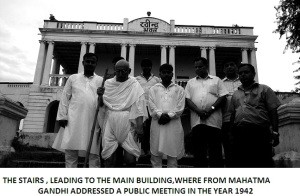 Tillha kothi (Rabindra Bhawan), is also being remembered for its role during the freedom movement. In the year 1942, when Mahatma Gandhi visited Bhagalpur, he was not allowed to address the public meeting in the city .A public meeting , was however organized in the foreground of the building,, where a large number of people participated. Mahatma Gandhi, addressed the crowd from the platform on the stairs of the building.
Tillha kothi (Rabindra Bhawan), is also being remembered for its role during the freedom movement. In the year 1942, when Mahatma Gandhi visited Bhagalpur, he was not allowed to address the public meeting in the city .A public meeting , was however organized in the foreground of the building,, where a large number of people participated. Mahatma Gandhi, addressed the crowd from the platform on the stairs of the building.
At present, Eastern wing, houses, Center for Regional Studies and the Western wing has a Museum of PG History department. The double storied middle portion, has two large halls, being used for organizing Seminar & Conference
Ghanta Ghar (Clock Tower):-
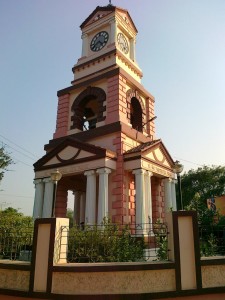 Ghanta Ghar is located in the heart of Bhagalpur. It is 25ft high Clock Tower made in British Time. Around it there is market place of the old city.
Ghanta Ghar is located in the heart of Bhagalpur. It is 25ft high Clock Tower made in British Time. Around it there is market place of the old city.
Tomb of Shuja :-
Tomb of Shuja, brother of Moghul emperor Aurangzeb is situated in the heart of the town. It is reminiscent of the city’s association with the Mughal period.
Dargah of Hazrat Shahbaz (1502):-
Khanqah-i-Shahbazia (Mullachak) :- It is situated adjoining the Bhagalpur Railway Station. Khanqah-i-Shahbazia was a highly reputed institution with a rich library and a rallying centre for scholars and men of learning. One of the five jurists invited by Aurangzeb for the compilation of his famous Fatwa-i-Alamgiri was Mir Muhammad Raadhi from Bhagalpur. In 1669 he received a daily allowance of three rupees and was later raised to the rank of an Amir. Sheikh Nizam, another noted theologian of his times was also welcomed to the Mughal court.Khanqah-i-Shahbazia, Mullachak continues to be a flourishing seminary under the care of the 13th generation of the descendants of Maulana Shahbaz. The Sajjadah Nashin (direct descendent) is supposed to spend his life within the boundaries of the Khanqah.This place springs a number of surprises like the oldest Shahi Mosque wrapped in black dome. The typical Bengali roof over the medieval tombs houses the Kadam-i-Rasool (footprint of the prophet) and other memorabilia dating back to the medieval days. The library of the Khangah is rich in Arabic and Persian theological works, which includes hand written books dating back to the days of Maulana Shahbaz. One of the prized collection of the library includes the Holy Quran transcribed by Murshid Quli Khan, the Nawab of Murshidabad who was fond of donating his works to various Khanqahs and even setting aside an allowance for their daily broadcast.
Moulana Chak Mosque :- It is built during the reign of Mughal emperor Jahangir and farrukhsiyar is famous pilgrimage for muslims because the sacred remains of Prophet Mohammed Shah is preserved here. .
Dargah of Makhdum Shah (1615):-
Bhikanpur mosque :- It is the 15th century Bhikanpur mosque is sparkling white and are considered to be very famous in Bihar
Shajangi hill top Dargah :-
This is situated in west-south from 2 Km. of Bhagalpur Railway Station. This is the place of Ibadat. The Pahlam of Muharram is taken at this place.
Shajangi Pir Ka Mazar:-
Shajangi Pond:-
Tilka Manjhi(or Jabra paharia) :-
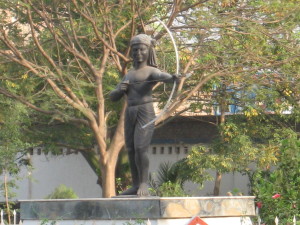 Baba Tilka Manjhi is a national hero. Tilka Manjhi also popularly known as “Jabra Paharia”. He was first Santal leader who took up the arms and raised his voice against English fought with them in the 1784’s, around 100 years before Mangal Pandey. So no doubt he was first freedom fighter of India. He made this movement a mass movement and circulated message written on leaf of Sal that “We must be united.” . He rose in rebellion against the misrule of the East India Company and shot dead the first collector of Bhagalpur Augustus Cleveland with bow and arrow from the top of banyan tree.The British surrounded the Tilapore forest from which he operated but he and his men held them at bay for several weeks.When he was finally caught in 1784, he was tied to the tail of a horse and dragged all the way to the collector’s residence at Bhagalpur. There, his lacerated body was hung from a same Banyan tree to show example for such deeds. A statue to the heroic leader was erected at the spot after independence on one corner of Sandish compound and the mohala has also been named as Tilka Manjhi in his memory.
Baba Tilka Manjhi is a national hero. Tilka Manjhi also popularly known as “Jabra Paharia”. He was first Santal leader who took up the arms and raised his voice against English fought with them in the 1784’s, around 100 years before Mangal Pandey. So no doubt he was first freedom fighter of India. He made this movement a mass movement and circulated message written on leaf of Sal that “We must be united.” . He rose in rebellion against the misrule of the East India Company and shot dead the first collector of Bhagalpur Augustus Cleveland with bow and arrow from the top of banyan tree.The British surrounded the Tilapore forest from which he operated but he and his men held them at bay for several weeks.When he was finally caught in 1784, he was tied to the tail of a horse and dragged all the way to the collector’s residence at Bhagalpur. There, his lacerated body was hung from a same Banyan tree to show example for such deeds. A statue to the heroic leader was erected at the spot after independence on one corner of Sandish compound and the mohala has also been named as Tilka Manjhi in his memory.
Also the Bhagalpur University was renamed after him Tilka Manjhi Bhagalpur University
Vishahri Asthan:-
Masjid of Mujahidpur (1511-15):-
SULTANGANJ BLOCK
Sultanganj :-
 It is situated about 25 km west of Bhagalpur on the bank of river Ganges on NH-80. Here is two hills. A hill by the bank of the river capped by a mosque while another rocky elevation in the midst of water riddled with temples of Shiva. The origin of Ajgaivinath temple at Jahangira or Sultanganj is not exactly known. Some claim it to be a Swayambhu, on the rock, discovered and then given an abode. That this is a very ancient place of worship there can be no doubt. The temple is solidly built on the rock and has got a series of marvellous rock sculpture and some inscriptions. Some of the specimens of the rock panel sculpture at this temple can hold their own against any of the best known specimens anywhere in India.
It is situated about 25 km west of Bhagalpur on the bank of river Ganges on NH-80. Here is two hills. A hill by the bank of the river capped by a mosque while another rocky elevation in the midst of water riddled with temples of Shiva. The origin of Ajgaivinath temple at Jahangira or Sultanganj is not exactly known. Some claim it to be a Swayambhu, on the rock, discovered and then given an abode. That this is a very ancient place of worship there can be no doubt. The temple is solidly built on the rock and has got a series of marvellous rock sculpture and some inscriptions. Some of the specimens of the rock panel sculpture at this temple can hold their own against any of the best known specimens anywhere in India.
Inscription probably in Pali script and the same language is also seen frequently on the stone slabs.
It is also traditionally associated with the sage Jahnu, whose ashram was a centre of learning and culture. Jahnu Muni’s ashram was located on the rock cutting out of the bed of the Ganga River. Now the site has the Shiva temple of Ajgaivinath. The story is that the river Ganga on her way to the ocean interrupted the Muni in his meditation by the rush of her currents. The sage swallowed the river in a grsp Raja Bhagiratha intervened and the Muni again let her out by making a cut in his thigh. That is why the river Ganga is also called Jahnavi.Traditionally Sultanganj was a part of the great Ango Pradesh in the days of Mahabharata.
It is a place of hoary antiquity. Between the two hills there are smaller granite formations with a number of interesting Gupta period carvings. These artistic etchings on the rock depict a variety of Hindu goddess, besides Buddha and Mahavira.
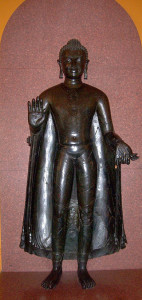 Sultanganj shot to fame in 1861 when a railway engineer, during the construction of railway track between Calcutta and Varanasi, stumbled upon a stupa that yielded a mighty 2.5 m high 1 m wide weight over 500 kg bronze statue of Buddha in Abhaya mudra, dating back to fifth century. It is the largest complete bronze statue of its kind in the world. It is now in Birmingham Museum and Art Gallery.
Sultanganj shot to fame in 1861 when a railway engineer, during the construction of railway track between Calcutta and Varanasi, stumbled upon a stupa that yielded a mighty 2.5 m high 1 m wide weight over 500 kg bronze statue of Buddha in Abhaya mudra, dating back to fifth century. It is the largest complete bronze statue of its kind in the world. It is now in Birmingham Museum and Art Gallery.
Shravani Mela:-
A large number of pilgrims visit this place in the month of Shravana (July-August), in order to fetch water from the Uttar Bahini Ganga. After walking bare feet for about 90 km , on the newly constructed Kawaria path from Sultanganj to Deoghar, to offer prayers and pour the Gangajal (Holy Water) on the deity. 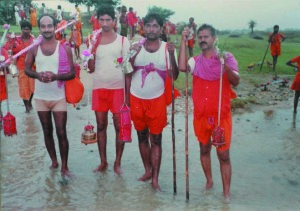 The legend of Ajagaibinatha is associated with Baba Harinath Bharti a regular visitor and fervent devotee of Shiva. On his way to Deogarh, he once emptied his pot of water to quench the thirst of a dying man. He was left with no water for Shiva at Deoghar. Consequently, he was returning to Sultanganj when he heard a voice telling him that Shiva was pleased by his devotion and he could now worship him at Sultanganj as well.
The legend of Ajagaibinatha is associated with Baba Harinath Bharti a regular visitor and fervent devotee of Shiva. On his way to Deogarh, he once emptied his pot of water to quench the thirst of a dying man. He was left with no water for Shiva at Deoghar. Consequently, he was returning to Sultanganj when he heard a voice telling him that Shiva was pleased by his devotion and he could now worship him at Sultanganj as well.
Murli Pahad( Masjid):-
This is another site at Sultanganj. A mosque is situated at the top of the hill. Remnants of tunnel and caves can be seen on both Ajgaivinath and the Murli Pahar hill where saints used to meditate . Stone statues and idols of Hindu and Jain gods are frequently seen on both the hills.
A large number of medieval sculptures by ASI in year 1959-60 were found here.
Idgah:-
Fathehganj Makbara :- It is located in idgah which is built in the 17th century.
Sultan shah Auliah (Sultanganj) :-
Baba Zalaluddin peer baba(Sultanganj) :-
Jahangira :- During the course of exploration done by The department of Ancient Indian History and Archaeology, Patna University in year 1968-69, observed traces of a ancient mound about 8 km to the west of Sultanganj on the Sultanganj- Bhagalpur road. The ancient mound here is being eroded by the river Ganga. Along the eroded bank, which is quite high at this place one can notice ring -well and remains of brick wall. The pottery recovered from the eroded bank included crude and fine varietes of black-and-red ware along with its associated types and the N.B.P. ware.
Church:-
Old Cemetery:-
SHAHKUND BLOCK
Kheri Hill :- Remnants of old buildings and temples have been found on the Kherhi Hill and its vicinity. A number of ancient tanks, sculptural and architectural remains etc., presently existing at the site, appear to be belonging to the early medieval period. A number of religious sculptures, mostly of black stone, such as those of Nrisingha, Lakshmi, Vishnu, Ganesh, Durga, besides Buddha, Tara etc. were earlier found from this site. These are of great archaeological significance.
Shahkund:- Shahkund in the district of Bhagalpur is situated at a distance of about 13 kms. from Sultanganj. Shahkund is a big tank measuring 1300 ft. x 600 ft. It is situated on the northern edge of a grave of a Muslim saint named Shah Saheb. The village proper is situated at the foot of a hillock called the Kheri Pahar (Hill). In a well of the village, large number of ancient relics consisting of broken sculptures and architectural pieces besides railings were found which clearly suggest that Shahkund had an ancient tradition.During the rule of Shashanka, the king of Bengal in the 7th century A.D. Shahkund appears to have been included within his kingdom. A number of ancient tanks, sculptural and architectural remains etc., presently existing at the site, appear to be belonging to the early medieval period. A number of religious sculptures, mostly of black stone, such as those of Nrisingha, Lakshmi, Vishnu, Ganesh, Durga, besides Buddha, Tara etc. were earlier found from this site. These are of great archaeological significance. Shahkund is particularly famous for the large number of Shivalingas, some of which are still existing on or near the site, one of which has a number of miniature Shivalingas (Sahasralinga) around its body.
Shahakund Police Station :- Important collection of sculpture ranging indate from the sixth-seventh to the twelfith-thirteenth centuries on the kherhi hill, situated in Shahakund Police Station. (ASI1959-60)
SABOUR BLOCK
Bihar Agricultural college(Sabaur):-It is located in Sabaur, Near sabour railway station. It is a Premier instution of Agricultural and Research in the country.It was established on 17 th August 1908 as a Bengal Provincial College by Sir Andrew Fraser , Lieutenant Governor of Bengal . As a Bihar Agriculture college, started education Programme in Agriculture during 1910 . B.Sc(Ag) degree course was started by first Principal Dr. J.S.Patel On Jan 10, 1944.The graduate course started in the year 1955 in Horticulture Agronomy, Plant Pathology, Entomology and extension Education disciplines. Now a day the College is under Rajendra University Pusa.
Sabalpur :- During the course of exploration under village to village survey done by ASI in year 1992-93, a ancient temple thakurbari was found.
Pirdauri :- During the course of exploration done by ASI in year 1979-80, discovered an extensive mound yielding N.B.P ware, grey and red wares, besides terracotta bangle pieces on the bank of Ganga.
PIRPAINTI BLOCK.
Mosque(Pirpainti):- It is situated 5 km north of Pirpainti railway station . It is an old mosque locally believed to have been constructed during the Mugal period.
NAUGACHIA BLOCK
Dudheswara Mahadeva Temple:-
Venkateswara Temple:-
KHARIK BLOCK
NARAYANPUR BLOCK
GOPALPUR BLOCK
Daughters of Forest (Dharhara village) :- Dharhara, a small village about km north-east from Bhagalpur . It is about 230 km east of Patna. Birth of Daughter and planting 10 fruit bearing Trees is going on in Dharhara during 1961. When Nirmala Devi gave birth to a girl , her husband celebrated by planting 50 mango saplings. The births of her second daughter and, years later, grand daughters were celebrated in a similar fashion by her family in Dharhara .The tradition has been followed till date. The total area of village is 1200 acres of which 400 actes are fully covered with fruit bearing trees.With a population of a little over 5000 the village has more than 100,000 fully grown trees, mostly of mango and lychee. The village looks like a forest or a dense green patch amidst the parched and arid cluster of villages in the area.
A Pipal tree which has been home to bats or “Chamgadar” as harbinger of goodwill in the village.
Bihar Chief Minister Nitish Kumar planted mango tree in the name of Lavi Kumari, born to the proud parents – Saurabh Singh and Priyanka Devi, on dated 6.6.2010 and greeted the villagers of Dharhara for setting a positive example to their fellow countrymen to treat the girl child as an asset and not a liability . The villager also present mango tree to C.M. which is planted in C.M.House.
Shivala (Saidpur) :- During the course of exploration under village to village survey done by ASI in year 1982-83, located a broken image of lord Buddha in a temple.
BIHPUR BLOCK
ISMAILPUR BLOCK
RANGRACHOWK BLOCK
GORADIH BLOCK
Pithana:- As per exploration done by KP Jayaswal Research Institute marked Period of site as Early medieval. Koyla Dih:- As per exploration done by KP Jayaswal Research Institute marked Period of site as Early medieval. Kurudih:- As per exploration done by KP Jayaswal Research Institute marked Period of site as NBPW Phase. Sri Rampur:- As per exploration done by KP Jayaswal Research Institute marked Period of site as Early medieval
Shikargarh (Tarchha) :- A minaret, known as ‘Shikargarh’ of time of Shuja, son of Shah Jahan was noticed by ASI in year 1960-61.
KAHALGAON BLOCK
Kahalgaon :- It is situated 32 km east of Bhagalpur. It is made up of three small islands. It is one of the oldest religious and trade centre in Bhagalpur commanding a picturesque view.
Legend associated with Jahnu Rishi’s with the swallowing of the Ganges when his meditation was interrupted by the rush of water. Later he released the Ganges through a cut on his thigh at the request of Raja Bhagiratha. Since then the river changed its course and started flowing from south to north. An incomplete and unusual rock cut temple worked out on a single granite boulder is of great interest as such a similar monolithic temple is not to be seen elsewhere in Bihar. Kahalgaon is the place to watch the dolphins at play around these islands.
According to Jayaswal Research Institute Archaeological Explorations this site belongs to Early medieval period.
Shankar Sah Vikramshila College:- It was the main stock center of business of indigo(Nil, used for white cloth) at the time of The British rule in India.This college was established by Badri Narain Sinha, IPS then SP of Bhagalpur in 1960s.
Tapas Dham temple (Shanti Baba Temple):- It is situated amid of Ganga River, 500 m away from the bank of the river. It is Shiva temple known as Tapas Dham Temple or Shanti Baba Temple.
Bateshwar Asthan :-
It is about 10 Km North East of Kahalgaon. Bateshwar Asthan is famous for 6th to 7th Century rock sculptures referred to as Chaurasi Muni (84 sages) around the confluence of Kosi and Ganga .
Flow of the Ganges is northerly here also so this place becomes religiously important. It is an isolated hilly area known as Bateshwar hill which is a part of Raj mahal system of trappean rocks. There are two temples of lord shiva. The temple on the bank of the Ganges is on a spheroidal block of hilly rock. This is called Bridheshwar nath or Burha baba. Second temple is about 150 metres up slope on eastern side on the hill top. It is called Bateshwar nath or Madeshwar nath built between 6th to 8th Century .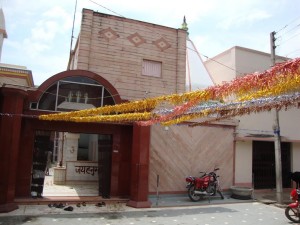
Mythology goes that the area was developed by Buddhist saint teacher and professor Kampilya, who mastered the art of meditation in Mahamundtri from the Nalanda university.
Another mythology goes that the area was ruled by rude administrator Vakul and Vikram He did not like salvation preaches of lord Budha So lord Budha on his retirement stay during one rainy season destroyed them on the rocks of Bateshwar. So the name Vikram shila.
The place depict various scenes from Ramayana. It was not only a scenic attraction but a popular tantric site as evident from the presence of a Kali temple instead of Parvati’s in front of Shiva temple, besides various other caves and rock cut sculptures dating back to the 6th to 7th Century A.D. There is Status of 84 meditating saint are seen encarved on the hills of Bateshwar asthan . They used to meditate in the cave and the tunnel which are still reserved in the hill.They are
Tri gufi— West of thakurbari hill near the bank of the Ganges
Basibt meditation center near bateshwar temple.
Patalpuri cave—In the North West side of the hill, it is the biggest of all the caves
Archeologist have found a statue of Bhairavi which has four eyes and twelve hands, is made of ashtadhatu. It is preserved in Indian museum at Kolkata. Figures and sketches of Ramayan and Mahabharat are also seen engraved on different stone blocks of the hill.
Many full size statues and partial statues of lord Vishnu , Nagkanya and Buddha can seen . A beautiful statue of the Sun God is also worshiped in the temple .
Naga baba temple is another attraction of the site.
Mahmud Shah’s Tomb :- It is situated in Kahalgaon which is at a distance of about 30 km , East of the district headquarter, Bhagalpur . Mahmud Shah was the last independent King of Bengal who died at Kahalgaon in 1539 A.D. After his defeat at the hands of Sher Shah, the mighty Pathan ruler, he took refuge with the Mughal Emperor Humayun at Chunar. In his absence from Bengal his capital was stormed and sacked and his two sons were murdered by the Afghans. After hearing the news of the death of his two sons and the plunder of his capital, he was so much shocked that only after a few days’ illness he died at Kahalgaon , where his tomb was built later. The tomb of Mahmud Shah is, therefore, of great historical significance.
Kahalgaon Super Thermal Power Station:-
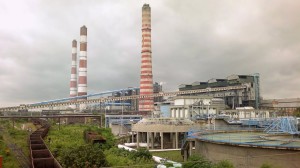 The power plant is one of the coal based power plants of NTPC. The coal for the power plant is sourced from Rajmahal Coalfields of ECL. . Source of water for the power plant is Ganga River.The total installed capacity of the plant is 2340 MW. This power plant serves as a beneficiary for West Bengal, Bihar, Jharkhand, Orissa, Sikkim states.
The power plant is one of the coal based power plants of NTPC. The coal for the power plant is sourced from Rajmahal Coalfields of ECL. . Source of water for the power plant is Ganga River.The total installed capacity of the plant is 2340 MW. This power plant serves as a beneficiary for West Bengal, Bihar, Jharkhand, Orissa, Sikkim states.
Vikramasila Monastery(Vikramshila University) (Antichak):-
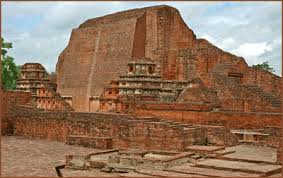
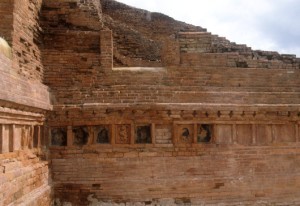 Vikramshila is a small town located 40 km from the city of Bhagalpur at Vikramshila Halt ,about 10 km north of Kahalgaon and 291 km from Patna.The small town is famous for housing Vikramshila University, the royal university ranks next to Nalanda, which was founded under the guidance of Dharmapala, a Pala king of 8th century AD. Situated on top of the hills along the banks of river Ganges, the university became a learning center of Tantric Buddhism.During the ancient period, there was a temple located at the center of Vikramshila University. A life-size copy of the Mahabodhi tree was enshrined in this temple. It is believed that around 108 temples were constructed around it. The study of Guhyasamaja Tantra was carried out in 53 of those temples.After prosperous for years, it was plundered by invaders around 1200 AD. In the present times, Vikramshila stands as a site for the remains of this University,
Vikramshila is a small town located 40 km from the city of Bhagalpur at Vikramshila Halt ,about 10 km north of Kahalgaon and 291 km from Patna.The small town is famous for housing Vikramshila University, the royal university ranks next to Nalanda, which was founded under the guidance of Dharmapala, a Pala king of 8th century AD. Situated on top of the hills along the banks of river Ganges, the university became a learning center of Tantric Buddhism.During the ancient period, there was a temple located at the center of Vikramshila University. A life-size copy of the Mahabodhi tree was enshrined in this temple. It is believed that around 108 temples were constructed around it. The study of Guhyasamaja Tantra was carried out in 53 of those temples.After prosperous for years, it was plundered by invaders around 1200 AD. In the present times, Vikramshila stands as a site for the remains of this University, 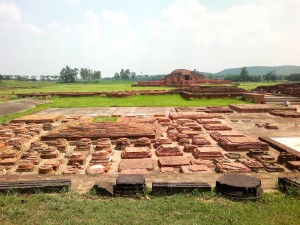
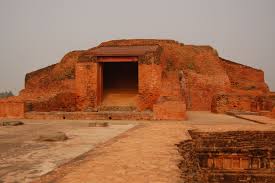 which was built with bricks and decorated with terracotta plaques in the walls of the two-tier circumambulatory paths. Carved pillars, Buddhist images and pictures of Hindu deities have been excavated from this ancient site. As one descend down the excavation site, one would find the remains of Tibetan dormitory, built on a 60 feet wide platform. This dormitory is being further destroyed due to the alkalisation of the bricks. Two of its columns have already been damaged. Adjacent to it lies the meditation house which is in complete ruins, surrounded by overgrown grass and thick layers of dust. The terracotta on its wall is also decaying. The soil around three of its main entrances is still to be dug out. The 60-feet high Stupa is built on a 300-feet wide platform. More than 300 terracotta figurines were fixed around this Stupa. During the excavation terracotta sealing was found. It shews in the countersunk surface, a line of writing in early Nagari characters of about the tenth century and in sanskrit language. It read Sri- Purushottam Apalah.
which was built with bricks and decorated with terracotta plaques in the walls of the two-tier circumambulatory paths. Carved pillars, Buddhist images and pictures of Hindu deities have been excavated from this ancient site. As one descend down the excavation site, one would find the remains of Tibetan dormitory, built on a 60 feet wide platform. This dormitory is being further destroyed due to the alkalisation of the bricks. Two of its columns have already been damaged. Adjacent to it lies the meditation house which is in complete ruins, surrounded by overgrown grass and thick layers of dust. The terracotta on its wall is also decaying. The soil around three of its main entrances is still to be dug out. The 60-feet high Stupa is built on a 300-feet wide platform. More than 300 terracotta figurines were fixed around this Stupa. During the excavation terracotta sealing was found. It shews in the countersunk surface, a line of writing in early Nagari characters of about the tenth century and in sanskrit language. It read Sri- Purushottam Apalah.
An inscription on the pedestal of a Tara image, it records in corrupt sanskrit written in proto-Bengali characters of the eleventh century the gift of Pratihara Udayarara.
Archaeological Museum Vikramshila:-
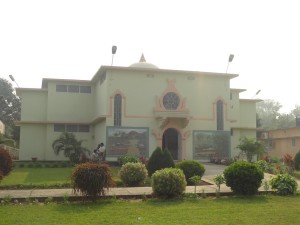 The museum is located at Antichak . It is established in year 2004 to display the antiquities recovered in course of excavation at the site. The museum building forms a cruciform on plan. A scaled model of the excavated site of Vikramshila is on display at the first floor of the building.The first floor also displays the antiquities like beads of various shapes, pendants, locket, finger rings, terracotta animal and bird figurines, perforated pot Bronze images of Buddhist and Brahmanical deity and shell objects and stone sculptures of Buddhist pantheon such as Buddha, Manjushri Vajrapani, Avalokiteshvara. The ground floor of the museum exhibits stone sculptures of Buddhist pantheon such as Buddha, Bodhisattva, Avalokitesvara, Loknath, Jambhala, Marichi, Tara, Aparajita.
The museum is located at Antichak . It is established in year 2004 to display the antiquities recovered in course of excavation at the site. The museum building forms a cruciform on plan. A scaled model of the excavated site of Vikramshila is on display at the first floor of the building.The first floor also displays the antiquities like beads of various shapes, pendants, locket, finger rings, terracotta animal and bird figurines, perforated pot Bronze images of Buddhist and Brahmanical deity and shell objects and stone sculptures of Buddhist pantheon such as Buddha, Manjushri Vajrapani, Avalokiteshvara. The ground floor of the museum exhibits stone sculptures of Buddhist pantheon such as Buddha, Bodhisattva, Avalokitesvara, Loknath, Jambhala, Marichi, Tara, Aparajita.
Opening Hours : 10.00 am to 5.00 pm
Closed on – Friday
Oriup :- The department of Ancient Indian History and Archaeology, Patna University has done survey within a radius of 10 km at Antichak area in year 1965-66. A mound about 2 km south-west of the Antichak yielding the N.B.P ware and other associated ceramics and chalcolithic pottery as represented by plain as well as white-painted black-and-red ware .
Chandipur :- The department of Ancient Indian History and Archaeology, Patna University has done survey within a radius of 10 km at Antichak area in year 1965-66. A mound about 3 km southern side of the stupa mound locally called Dharohar mound at Antichak yielding tools of the middle stone age from the nullah close to the hilly belt.
Lalpur :- The department of Ancient Indian History and Archaeology, Patna University has done survey within a radius of 10 km at Antichak area in year 1965-66. A mound about 1.5 km north- eastern side of the stupa mound at Antichak yielding beads and microliths of chalcolithic assemblage
Malakpur :-The department of Ancient Indian History and Archaeology, Patna University has done survey within a radius of 10 km at Antichak area in year 1965-66. A mound about 1.5 km south- east side of the stupa mound at Antichak yielding late stone age tools including blades, points, knife-blades. Excavation done on the mound in the year 1979-80, where a villager had encountered a large number of unbaked clay pellets representing miniature figures of Buddha in bhumisparsa mudra, revealed disturbed votive stupas just below the humus.
Mamsukh- Kothi :- The department of Ancient Indian History and Archaeology, Patna University has done survey within a radius of 10 km at Antichak area in year 1965-66. A mound about 2.5 km north- east side of the stupa mound at Antichak yielding fine variety of late stone age tools including blades, blade-cum-points, knife-blades, scrapers and cores.
Jangalisthan :-Excavation done on the mound found at Jagalisthan about 0.5 km north- west side of the main monastery at Antichak in year 1979-80. A rempart-wall with salients, built of brick was found. The rampart seems to have been built in the early fourteenth century A.D. The important finds recovered from the site are torsos of Buddha and Bhairava and a panel representing navagrahas with their respective vahanas all in stone.
Patharghata Hills :- It is situated about 13 km north – east of Kahalgaon. It is faces the river Ganges just where the river resumes its easterly course. It is famous for their Jurassic Age rocks and natural fossils. On the northern side of the hill are some rock sculptures dating prior to the 7th or 8th century .A.D. There are known as the Chaurasi Munis but are supposed to represent scenes from the adventures of Lord Krishna and Rama.
The hill also contains five caves, Madhorampur Patalpuri cave, Bateshwar cave .This place is also ideal for Ecotourism development.
Golgong Rock Temple :- Golgong temple is famous for its rock cut carvings, which date back to Gupta period (5th-7th Century CE). These carvings depict a number of Hindu, Buddhist and Jain deities. The remains of these structures have been discovered from Sultanganj and Kahalgaon in the Bhagalpur.
Kasri:- It is situated east of Bhagalpur bank of Ganga on Nh 80 in oriup panchayat. Durvasa Muni Asram (Kasri Pahari) is here.
Chhoti Lalapur:- As per exploration done by KP Jayaswal Research Institute marked Period of site as Early medieval.Kashari:- As per exploration done by KP Jayaswal Research Institute marked Period of site as Early medieval.Khiri Ghat:- As per exploration done by KP Jayaswal Research Institute marked Period of site as Early medieval.Bhawanipur:- As per exploration done by KP Jayaswal Research Institute marked Period of site as Early medieval. Kuttupur:- As per exploration done by KP Jayaswal Research Institute marked Period of site as Medieval.Allipur:- As per exploration done by KP Jayaswal Research Institute marked Period of site as Medieval.
SONAHULA BLOCK
Kajha:- As per exploration done by KP Jayaswal Research Institute marked Period of site as Early medieval. Olpura:- As per exploration done by KP Jayaswal Research Institute marked Period of site as Early medieval. Fardampur:- As per exploration done by KP Jayaswal Research Institute marked Period of site as NBPW phase. Kushaha:- As per exploration done by KP Jayaswal Research Institute marked Period of site as Medieval. Srimatpur:- As per exploration done by KP Jayaswal Research Institute marked Period of site as Early medieval. Chandi Asthan:- As per exploration done by KP Jayaswal Research Institute marked Period of site as Early medieval. Sanokhar:- As per exploration done by KP Jayaswal Research Institute marked Period of site as Early medieval. Tarar:- As per exploration done by KP Jayaswal Research Institute marked Period of site as Early medieval. Ranjeet Garh:– As per exploration done by KP Jayaswal Research Institute marked Period of site as Early medieval. Bhuria:- As per exploration done by KP Jayaswal Research Institute marked Period of site as Medieval. Pannuchak Ghogha:– As per exploration done by KP Jayaswal Research Institute marked Period of site as Early medieval
NATHNAGAR BLOCK
Champanagar :- Champanagar is a western suburb about 3.5 km away of the Bhagalpur town in Nathnagar Block. It consists a large hillock or flat-topped mound surrounded by a moat , referred to as Kangarh or the palace of Raja Karn .The city of Champa, as capital of the ancient kingdom of Anga, is found frequently mentioned in ancient Indian literature. King Karna of the Mahabharata is said to have ruled from here. Today this elevated ground houses a century old Sanskrit school beside a famous Mankamneshwar Nath Mandir in the corner while the vast field continues to be the playground of the freshly recruited policemen(Bhagalpur Police Training School).Champanagar is considered by the Jains as one of their sacred places of pilgrimage. In the Kalpa-Sutra Champa is mentioned as one of the places where the last Tirthankara Mahavira stayed for three rainy seasons in the course of his religious wanderings. According to the prevalent Jain tradition it is believed that Jain Tirthankara Vasupujya was born at Champanagar or Champapuri.The main temple of Champapur Siddha Kshetra is quite ancient (about 2500 years).The Reddish Diamond colored Padmasana idol of Bhagwan Shri Vasupujya seated on the principal altar of main temple is quite attractive and beautiful. Champapur is the only ‘Panch Kalyanaka Kshetra’ in the world which is related to Panch Kalyanaka: – “(i) Garbha, (ii) Janma, (iii) Tapa, (iv) Gyan and (v) Moksha” of 12th Tirthankara Bhagwan Vasupujya (The first ascetic saint). Another idol of Bhagwan Vasupujya is made of ‘Ashtadhatu’ (Alloy of eight metals) & the ancient foot images of Bhagwan Vasupujya with an inscription dated V.S. 1694 or 1637 A.D.are also installed in this altar. There is ‘Ashta -Pratiharya’ created in an artful specimen of glass present in this temple that is marvelous. One ancient ‘north oriented Adinath Jinalaya’ is also present in southern campus near the main temple.
One ‘Kushan periodic’ Khadgasana idol of Bhagwan Adinath is also installed here which is 2000 years ancient. These are many more ancient idols present in this temple. In this temple only the images of 24 Tirthankaras are present on one marble collectively and this looks marvelous & unique.The entrance gate of this temple is made in the style of Hawamahal of Jaipur (the Pink City), is great, attractive & artistic.Champapur is also related to great stories of ‘origin of Harivansha, Shripal-Mainasundari, Shri Dharma Ghosh Muni, King Karna of Mahabharata, King Mudrak and great architect Vishvakarma’.
One magnificent ‘Jal Mandir’ is also situated here, in which 16 feet high idol of Bhagwan Vasupujya is installed on big lotus flower. The water is filled in artificial lake around the altar. The huge umbrella of marble is present over the idol and behind this idol the pink colored halo is also present and magnifying the beauty of idol.A excavations in and around the site reveal the traces of fortified complex besides an abundance of North Black Polished wares. Archaeologists have ascertained that the rampart was made of rammed earth was later (2nd century B.C.) riveted with burnt bricks.
There are Several Mazars.
According to Jayaswal Research Institute Archaeological Explorations this site belongs to Late medieval period.
Kangarh:- Champanagar consists a large hillock or flat-topped mound surrounded by a moat , referred to as Kangarh or the palace of Raja Karn .The city of Champa, as capital of the ancient kingdom of Anga, is found frequently mentioned in ancient Indian literature. King Karna of the Mahabharata is said to have ruled from here.
According to Jayaswal Research Institute Archaeological Explorations this site belongs to Early medieval deriod.
Vishhari Sthan (Snake Temple)(Nathnagar):- It is situated about a mile to the west of Champanagar. It is the place where the religious Hindu festival of “Vish-hari Puja” or “the worship of the Snake Queen” traces its roots back hundreds of years and is still celebrated every year with thousands of believers and snake charmers offering milk to the Nag (the Snake King) and Nagin (The Snake Queen). It is celebrated during the bright fortnight of the month of shravana ( July-August).
Mansa Devi Temple:-
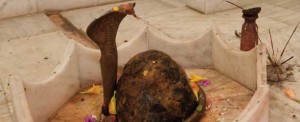
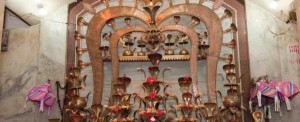 A mythological story, says one daughter of Shiva was born from the lock of his hair. On Lord Shiva’s suggestion the Goddess appeared in the dreams of one Chandradhar Saudagar, who then started to worship her. But Jaya Vishari, the sister of the goddess offered frogs made with the dough of flour for the army of snakes belonging to the Goddess, something that angered Chandradhar and he stopped the worship, leaving it incomplete. The goddess felt great humiliation and by stinging, killed his six sons. She did not want that any future generation should carry his name forward. This is why Mansa Devi is also called Goddess Vishari.
A mythological story, says one daughter of Shiva was born from the lock of his hair. On Lord Shiva’s suggestion the Goddess appeared in the dreams of one Chandradhar Saudagar, who then started to worship her. But Jaya Vishari, the sister of the goddess offered frogs made with the dough of flour for the army of snakes belonging to the Goddess, something that angered Chandradhar and he stopped the worship, leaving it incomplete. The goddess felt great humiliation and by stinging, killed his six sons. She did not want that any future generation should carry his name forward. This is why Mansa Devi is also called Goddess Vishari.
Somehow, Chandradhar’s son Bala escaped the wrath of the Goddess. He was kept in a cage of iron with Chandradhar’s daughter-in-law Bihula, but eventually Goddess Mansa, in the form of a snake attacked Bala, who too died. Subsequently Chandradhar accepted the supremacy of the Goddess and apologised to her for his deeds. Pleased with this, the Goddess brought his sons back to life and it was from then onwards that Mansa Devi came to be worshipped. Devotees who get their wishes fulfilled, offer brass pots to the Goddess. Innumerable vessels are arranged one on top of another near the deity, creating a beautiful picture.
Champanagar Masjid (1491):-
Catholic Church :- It is situated near city Tower.
Royal bridge :- The Royal bridge is reminiscent of the Mughal forces who marched along this old road, Akbar camped here twice in 1575 but later the place was written off as the headquarter of the imperial faujdari (military governors). The Maratha forces on their way to Bengal in 1743 were confused at Bhagalpur and had to pay a hefty amount for seeking guidance and shortcuts to their destination. At the close of 18th century, Bhagalpur was reduced to a mere pargana in the Monghyr sarkar.
According to Jayaswal Research Institute Archaeological Explorations this site belongs to Late medieval period.
Bhim Kitta :- South West of the city was fortified by mud walls stretching from Bhim Kitta to Shah Janghi.
Old Tomb :- North-West elevation on the river side houses a seventeenth century tomb. Little is known about the person who is buried here in Champanagar but the inscription suggests its construction in 1622/23 by Khawaja Ahmed Samarkhandi. The tomb, often referred to as the dargah of Makhdoom Sahib features a typical Bengali roof.
Observation towers of the fort :- A mile from the Karngarh mound we find four elevations which are believed to have served as observation towers of the fort.
Old harbour :- During an archaeological excavation, many boats and coins of the Middle and Far East were found . It’s show the city had a big harbour on the Ganges River, which flows on the western boundary of the present city near Nathnagar.
Kailash Mountain :- The artificial ‘Kailash Mountain’ is constructed in the east.
Shripal – Mainasundari Garden (Nathnagar) :- Shripal-Mainasundari Garden’ which is the a tourist spot of Nathnagara bout 3 km from Bhagalpur. With the artificial constructed ‘Kailash Mountain’ in the east of Shripal- Mainasndari Garden it collectively present the beautiful sight of this Area.
Kailas Pahar :- During the course of exploration done by ASI in year 1983-847, brought to light of sculpture of Siva, Parvati, Kartikeya and Ganesha in a temple.
Mud- fortification wall :- During the course of exploration done by The department of Ancient Indian History and Archaeology, Patna University in year 1968-69, observed traces of a Mud- fortification wall near the bungalow of the Principal, Police Training School, Nathnagar, where the mound has been cut for taking the pipe line to the residential area situated on the outer side of the mound. Exploration yielded sherbs of plain as well as painted black- and -red ware from the lower deposits of the site and of the N.B.P ware from upper levels. Besides terracotta figurines of the Sunga period were also found.
Sahabganj:- As per exploration done by KP Jayaswal Research Institute marked Period of site as Medieval. Kabirpur:- As per exploration done by KP Jayaswal Research Institute marked Period of site as Late medieval. Tanti Bazar:- As per exploration done by KP Jayaswal Research Institute marked Period of site as Late medieval. Sohara Patti:- As per exploration done by KP Jayaswal Research Institute marked Period of site as Medieval. Hasanabad:- As per exploration done by KP Jayaswal Research Institute marked Period of site as Late medieval. Chauki Niyamatpur:- As per exploration done by KP Jayaswal Research Institute marked Period of site as Medieval. Bararipur:– As per exploration done by KP Jayaswal Research Institute marked Period of site as Medieval. . Narga:- As per exploration done by KP Jayaswal Research Institute marked Period of site as Medieval. Bhoalpur:– As per exploration done by KP Jayaswal Research Institute marked Period of site as Early medieval. Maskan-Bararipur:- As per exploration done by KP Jayaswal Research Institute marked Period of site as NBPW phase. Champapur:– As per exploration done by KP Jayaswal Research Institute marked Period of site as Early medieval.
Mahasai Deodi (Bangali Tola):- A typical Thakur Bari. Mahashay was the honorific hereditary title given by Akbar in 1664 to Sri Ram Ghosh, the collector. The Mahashay deori is worth a visit. It revives the memory of a typical Mughal Zamindar’s residence of deori replete with open courtyard.
According to Jayaswal Research Institute Archaeological Explorations this site belongs to Early medieval period.
JAGDISHPUR BLOCK
Purani :- It is 13 kilometres from Bhagalpur in Jagdishpur block. Integrated Handloom Cluster Development Program, sponsored by DC Handlooms, Ministry of Textiles, Govt. of India is undertaken in Bhagalpur District, Bihar. The blocks undertaken under this project are Jagdishpur, Goradih:- and Shahkund. There are 10 villages that are covered under these three blocks. The villages are Puraini, Momintola, Khwajanagar East, Khwajanagar West, Nayatola, Mustafapur, Kamalchak, Miranchak, Khaira and Imadpur.
Khalifa Bagh mosque :- The 15th century Khalifa Bagh mosque is sparkling white and are considered to be very famous in Bihar.
Khalifa Bagh:- As per exploration done by KP Jayaswal Research Institute marked Period of site as Medieval. Tilha Kothi (Company Bagh):- As per exploration done by KP Jayaswal Research Institute marked Period of site as Early medieval. Shahjangi:- As per exploration done by KP Jayaswal Research Institute marked Period of site as Medieval. Chhoti Khanjarpur:- As per exploration done by KP Jayaswal Research Institute marked Period of site as Earl medieval. Mayaganj:- As per exploration done by KP Jayaswal Research Institute marked Period of site as Early medieval. Sayedpur Barari:- As per exploration done by KP Jayaswal Research Institute marked Period of site as Late medieval. Mojahidpur:- As per exploration done by KP Jayaswal Research Institute marked Period of site as Medieval. Tatarpur:- As per exploration done by KP Jayaswal Research Institute marked Period of site as Late medieval. Mashaikh Chak:- As per exploration done by KP Jayaswal Research Institute marked Period of site as Late medieval. Quilla Ghat:- As per exploration done by KP Jayaswal Research Institute marked Period of site as Early medieval. Maulana Chak;- As per exploration done by KP Jayaswal Research Institute marked Period of site asMedieval. Sujaganj:- As per exploration done by KP Jayaswal Research Institute marked Period of site as Late medieval. Parbatti:- As per exploration done by KP Jayaswal Research Institute marked Period of site as Late medieval. Gani Dham:- As per exploration done by KP Jayaswal Research Institute marked Period of site as Early medieval. Desri:- As per exploration done by KP Jayaswal Research Institute marked Period of site as Early medieval. Manikpur:- As per exploration done by KP Jayaswal Research Institute marked Period of site as Early medieval. Champanagar (Mahashay Deorhi);- As per exploration done by KP Jayaswal Research Institute marked Period of site as Early medieval. Tanti Tola:– As per exploration done by KP Jayaswal Research Institute marked Period of site as Medieval. Jogasar:- As per exploration done by KP Jayaswal Research Institute marked Period of site as Early medieval. Husainabad:- As per exploration done by KP Jayaswal Research Institute marked Period of site as Late medieval. Nathnagar (Karn Garh/Champa Tila):- As per exploration done by KP Jayaswal Research Institute marked Period of site as NBPW phase. Anandpur:- As per exploration done by KP Jayaswal Research Institute marked Period of site as Early medieval.
Batuk Bhairab (Mahasaya Dyodhi Mandir) :-
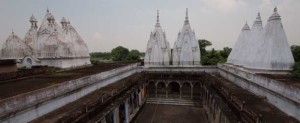 A temple with a strange deity called Batuk Bhairab ( Possibly a Buddhist image) which was discovered by the early Mahashays at Tilhakothi where they used to live during the Mughal days.
A temple with a strange deity called Batuk Bhairab ( Possibly a Buddhist image) which was discovered by the early Mahashays at Tilhakothi where they used to live during the Mughal days.
Who looks after the entire temple says, Mahasaya was the estate of Raja Amarnath Ghosh. Rani Padmavati, wife of Raja Amarnath, owns the credit of the exploration of Batuk Bhairavnath.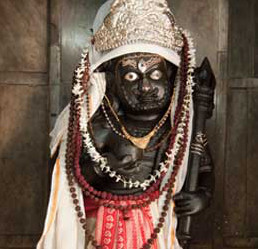 Bhairavnath came into the dreams of the Rani and told her that he was lying under the mud base of a pond.“The pond from where the statue was found, still exists and is situated in Sahibganj.“
Bhairavnath came into the dreams of the Rani and told her that he was lying under the mud base of a pond.“The pond from where the statue was found, still exists and is situated in Sahibganj.“
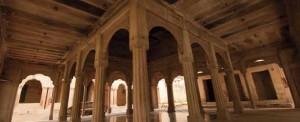 The architecture of this temple is close to the Rajasthani style. Pillars were made for erection of this temple by cutting.
The architecture of this temple is close to the Rajasthani style. Pillars were made for erection of this temple by cutting.
Legendary stories say that some time ago Batuk Bhairav Nath was disappearing in the night and devotees were worried how to keep him inside the temple. From then on they tied the statue with iron chains. The testimony of Batuk Bhairav Nath is available in the Bhagalpur gazetteer.
There is a sculpture of two black dark birds with a saint meditating in between on the premises. As per another belief, the two birds are actually sighted on the roof of the temple now and then on very short visits.
Visharhi Asthan temple:-
Durga Asthan:-
.
